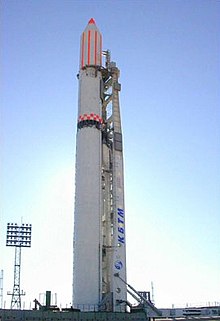 Zenit-2 at Site 45/1 | |
| Function | Carrier rocket |
|---|---|
| Manufacturer | Yuzhmash |
| Country of origin | Soviet Union (Ukraine) |
| Size | |
| Height | 57 metres (187 ft)[1] |
| Diameter | 3.9 metres (13 ft)[1] |
| Mass | 460,000 kilograms (1,010,000 lb)[1] |
| Stages | Two |
| Capacity | |
| Payload to LEO | |
| Mass | 13,740 kilograms (30,290 lb) 11,420 kilograms (25,180 lb) (ISS orbit)[1] |
| Payload to SSO | |
| Mass | 5,000 kilograms (11,000 lb) |
| Associated rockets | |
| Family | Zenit |
| Derivative work | Zenit-2M Zenit-3SL |
| Launch history | |
| Status | Retired |
| Launch sites | Baikonur Site 45 |
| Total launches | 36[2] |
| Success(es) | 28 |
| Failure(s) | 7 |
| Partial failure(s) | 1 |
| First flight | 13 April 1985 |
| Last flight | 10 June 2004 |
| First stage | |
| Powered by | 1 RD-171 |
| Maximum thrust | 8,180 kilonewtons (1,840,000 lbf) |
| Specific impulse | 337 s |
| Burn time | 150 seconds |
| Propellant | RP-1/LOX |
| Second stage | |
| Powered by | 1 RD-120 1 RD-8 |
| Maximum thrust | 912 kilonewtons (205,000 lbf) 79.5 kilonewtons (17,900 lbf) |
| Specific impulse | 349 s |
| Burn time | 315 seconds |
| Propellant | RP-1/LOX |
The Zenit-2 was a Ukrainian, previously Soviet, expendable carrier rocket. First flown in 1985, it has been launched 37 times, with 6 failures. It is a member of the Zenit family of rockets and was designed by the Yuzhmash.